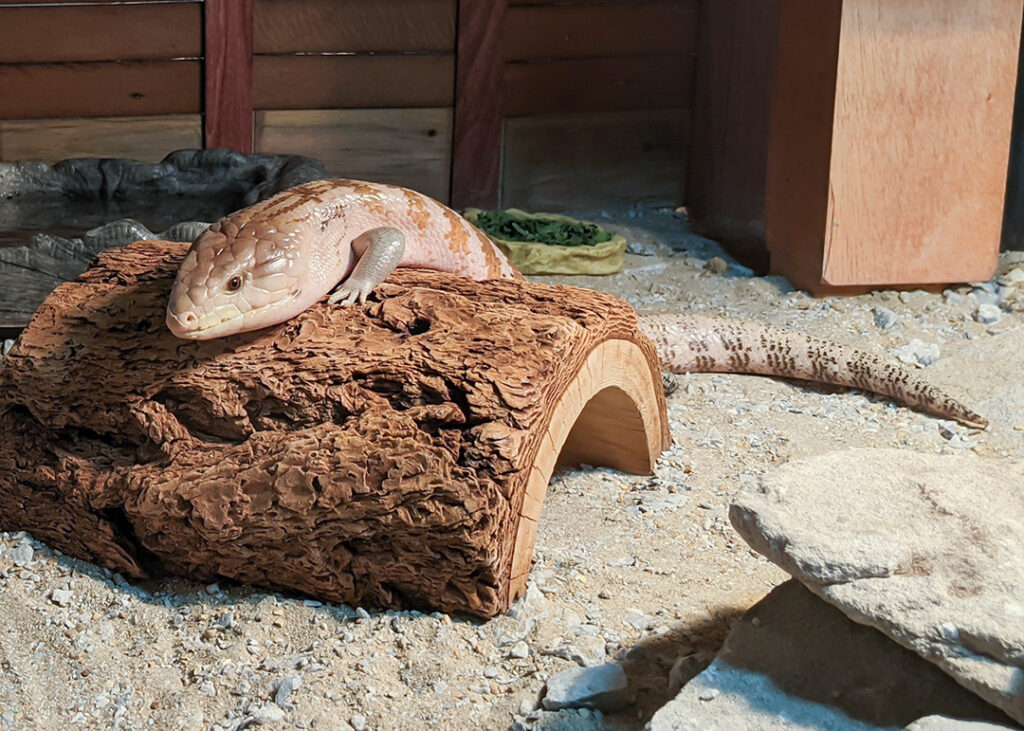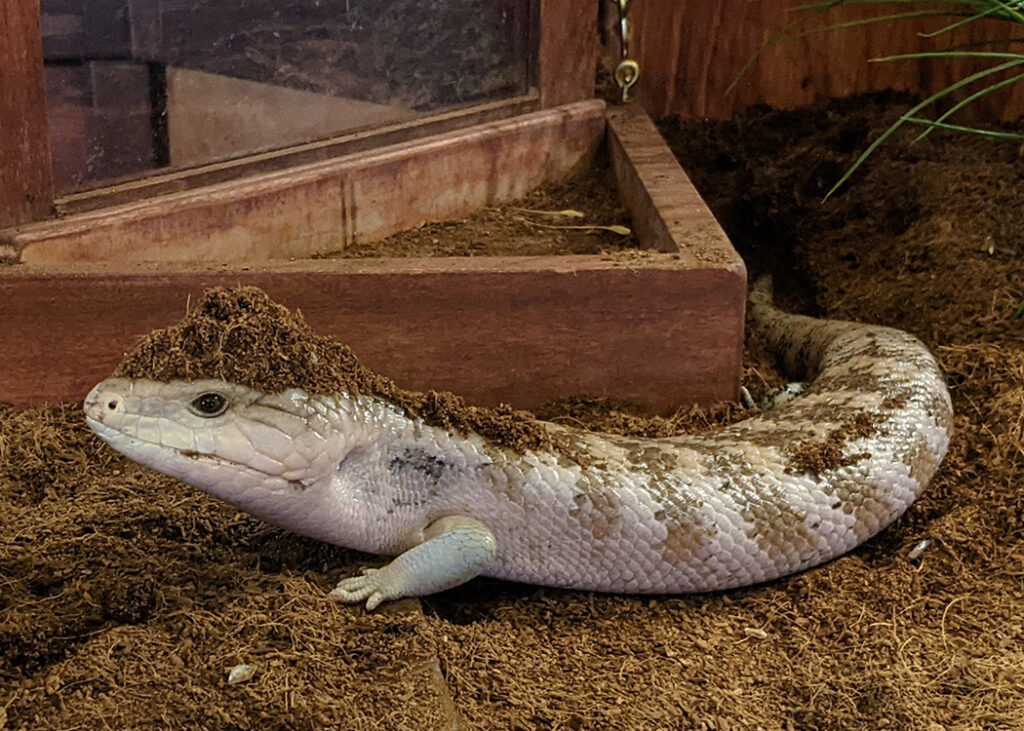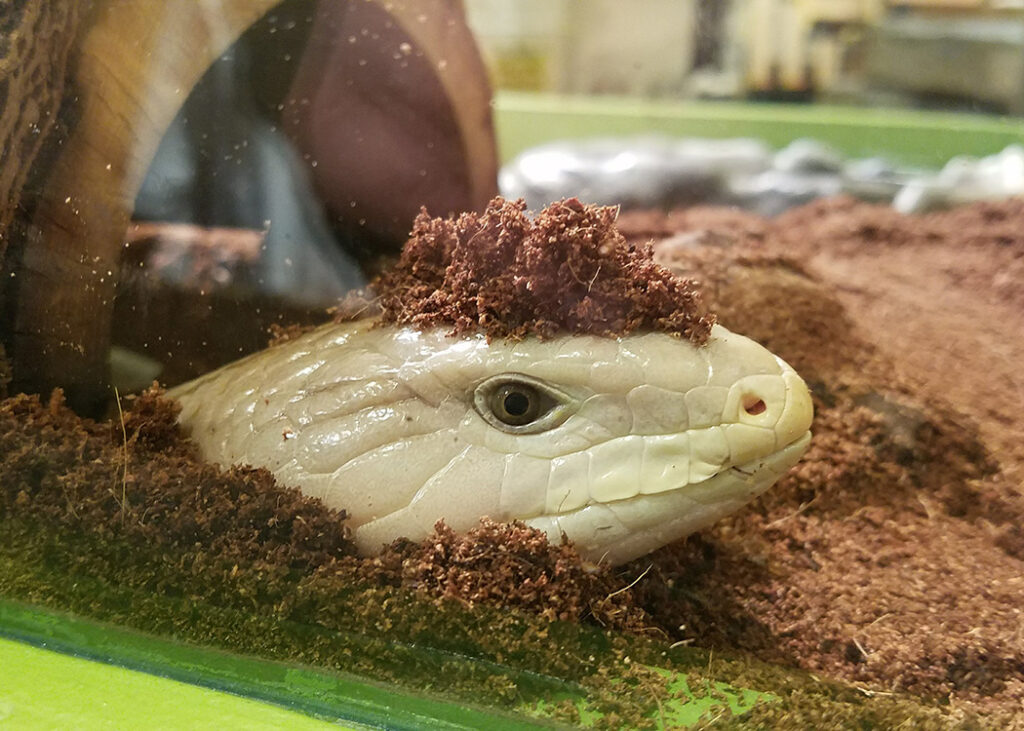Mooch and Norbert, WonderLab’s beloved Blue Tongued Skinks, are animals that hail from the savannas and deserts of Indonesia and Eastern Australia. While Norbert and Mooch take turns living in WonderLab’s climate controlled Hidden Life of Deserts habitat their wild counterparts living in natural habitats are experiencing many environmental stressors. Stressors such as wildfires and a quickly changing environment that puts food sources in jeopardy. Both of these issues, and other, are due in part to a phenomenon known as desertification.
What is desertification?
It is reasonable to look at the word, “desertification,’ and guess that it means ‘when land becomes a desert’ however, that simple definition is not accurate.
Deserts are vibrant, complex environments thriving with diverse life. Many types of plants and animals alike have adapted to the dryness of the desert – which has led to some of the most extreme adaptations and characteristics on Earth.
Desertification is different.
The United Nations Convention to Combat Desertification defined desertification as “land degradation in arid, semi-arid and dry sub-humid areas resulting from various factors, including climatic variations and human activities” [1].
Let’s unpack what this means.
The UN’s definition refers to areas near the hot equator that lose more water each year than they gain in precipitation. NOTE: Scientists excluded the north pole and Antarctica despite the fact that they too lose more water than they receive because cold deserts experience different environmental pressures than hot deserts (to learn more about Earth’s different types of deserts, click here).
“Land degradation” refers to the loss of an area’s productivity (ability to produce and sustain life) and complexity (having many diverse life forms).
Basically, desertification is when fertile, hot drylands near the equator permanently degrade to where they can no longer productively support life. It is NOT land simply turning into a “desert” it is land becoming devoid of life.
Why is desertification happening and how do we know?
Scientists typically categorize potential desertification factors into two categories: naturally occurring climate variance also known as bioclimatic drivers and human activities also known as anthropogenic drivers [1][2].
Scientists agree that bioclimatic drivers are naturally occurring forces that contribute to desertification. These include decreases in precipitation or how natural cycles of increased temperatures can make the soil become hydrophobic, or unable to take on water. As things warm up, water evaporates quicker and the air has trouble retaining the moisture allowing for even faster evaporation. The lack of rain also leads to salts building up in the topsoil causing salinization. These factors make it impossible for plants to survive. Without the roots of plants to hold the soil in place, wind can erode the topsoil, leaving behind hard, compact dirt with no usable nutrients for plants. When it does finally rain, the remaining soil can be whisked away in runoff [2]. Have you ever let a houseplant go too long without watering it and when you tried watering it, the water just pooled on the surface without penetrating to the roots and you had to soak in water or turn up the soil? That is the same process happening around the world. This then leads to increased albedo, or reflection of solar energy back to the atmosphere, since there are few plants to absorb it, which can further change atmospheric conditions decreasing precipitation more and exacerbating this cycle [5].
Scientists do not agree on the human’s role in this process. Some scientists think activities like poor land management such as overgrazing grasslands or soil compaction from cattle is a huge contributor [13]. Others believe poor irrigation practices mess up water systems by damming water in one area depriving the areas downstream [2] as well as pulling too much of the groundwater and killing the vegetation [13].
While climate change is a natural cycle Earth has seen for billions of years, it is usually a slow, gradual process. Increases in human greenhouse emissions are increasing how fast the climate is changing [17]. When the climate changes fast the environment and its inhabitants do not have the time to adapt. Increased CO2 could theoretically assist in plant growth, but that doesn’t happen in areas where plants have died out because there is no water to use for photosynthesis. In these areas the CO2 doesn’t get used and warms the planet [13].
Where is desertification happening?
Desertification is happening in Australia, Africa, The United States, South America [13], and Asia [9]. Even some nations in Europe, based on their own evaluations, are claiming to be seeing symptoms of desertification [14]. In addition to disagreeing on what influence humans have in desertification, scientists have also not agreed on a universal way of measuring desertification. This is because there are so many causes. Not every area experiencing desertification may be experiencing it in the same way for the same reasons. There is not a one size fits all cause, identification, or solution to this problem.
How might wild skinks be affected by this?
In one estimate, scientists calculated that 42% of the 5 million km squared of arid (dry) and semiarid lands in Australia has experienced desertification, primarily in the form of replacement of grasslands, savannahs and woodlands with shrubbery [3].
This is problematic for blue tongued skinks as their primary native habitat spans all three of those ecosystems [4]. Skinks like Mooch and Norbert are omnivores, meaning they eat both plants and animals. They depend on the flesh and fruits of cacti and other vegetation such as grasses not only for food but also as a large part of their water intake [4].
Shrubs are difficult for skinks to eat and digest. If their dietary vegetation is replaced with indigestible shrubs, they will need to find new habitats with food or they will die. Additionally, the loss of grasses is detrimental to a skinks ability to blend in. Skinks like Mooch and Norbert have a scale pattern that alternates between light and dark striping that mimics the shadows and shapes of grasses. This provides crucial to camouflage allowing skinks to blend keeping them hidden from predators and prey [4]. If grasses arereplaced with shrubs, they lose their protection.
Australia has a wet and dry season. Blue tongued skinks rely on the wet season to eat a lot and stock up on fat, specifically in their tails. The base of their tails have fat reserves on which they survive during the dry season or drought when food is scarce [4]. If the wet season does not get wet enough, they will not store enough food and water to get through the dry season. If the dry season gets longer, they will not have enough fat stores for survival. Additionally, if a predator attacks, bluies drop their tails to escape and survive [4]. Normally, the tails regenerate. But, if their native habitats are “desertified” they may find themselves without enough food and water to regenerate a tail which means they will starve.
Another seasonal challenge exacerbated by desertification: wildfires [13]. Forest fires are a natural part of the environmental cycle beneficial to habitats. Wildfires clear out dead debris making room for new growth, reducing the size of future fires, and preventing megafires. Some plant species rely on fire for their reproductive cycles or to create more space for sunlight to shine through the canopy [11]. However, when nature is out of balance, wildfires can be catastrophic. The 2019-2020 bushfire season in Australia, exacerbated by wildfires, was one of the deadliest and most devastating.
Finally, wild Blue tongued skinks are diurnal which means they are active during the day. In the most extreme desertification potential future, daytime temperatures could get so hot that skinks may become active in cooler times of the day, which is when the sun is down. This may render their namesake blue tongue adaptation useless. Blue tongue skinks use their tongues to communicate with each other, but not in the same way we do, with language. They open their mouths wide and stick out their tongues at each other. The bigger, brighter blue tongue is the one who wins whatever they were fighting over; blue tongues allow the skinks to compete without risking injury [4]. Bluies do not see blue the same way we do. Blue tongues skinks do not actually see ultraviolet as strongly as other diurnal lizards. They do however have not one but two types of shortwave photoreceptors, which means they can see many more variations of blue [6]. But a blue tongue just doesn’t have the same pizazz in the dark.
Concluding Thoughts from the Author
In just our lifetime Mooch and Norbert’s native homeland has seen an increase in the frequency, length and intensity of wildfires. Around the world there have been stronger and more devastating weather events. Here in Bloomington we have seen warmer winters with much less snow. In historically hot places, like Texas, they have had ice storms [12]. There have been longer droughts followed by catastrophic flooding.
Sometimes, It’s tough to have hope right now… It’s ok if you feel that way.
I just had a tough conversation with a friend of mine about this topic and he said he feels hopeful for Earth and our future. I asked him with genuine curiosity how he keeps such a sunny mindset about everything and I will never forget what he said: “Most people want to work together to make Earth a better place for everyone.” And that made me think of Mooch and Norbert, who live here at WonderLab not only to show us what their species is experiencing, but to teach us about empathy and compassion towards nature and everything and everyone who lives in it. I am so lucky to watch them build connections everyday between visitors and the rest of the world in ways I cannot.
 About the Author: Sam Couch is the Animal Exhibits Senior Manager at WonderLab. She graduated from Indiana University in 2017 with a B.S in Biology and a Certificate of Animal Behavior. She started at WonderLab as an intern in 2015 and never left. It has become clear to her through the years that everything is connected and that problems in one area will always undoubtedly have repercussions elsewhere. She tells this to everyone who will listen.
About the Author: Sam Couch is the Animal Exhibits Senior Manager at WonderLab. She graduated from Indiana University in 2017 with a B.S in Biology and a Certificate of Animal Behavior. She started at WonderLab as an intern in 2015 and never left. It has become clear to her through the years that everything is connected and that problems in one area will always undoubtedly have repercussions elsewhere. She tells this to everyone who will listen.
Citations
- United Nations Convention to Combat Desertification. 1994. https://catalogue.unccd.int/936_UNCCD_Convention_ENG.pdf
- The Condition and Trends Working Group. Ecology and Human Well-Being: Current State and Trends: Millennium Ecosystem Assessment; Vol 1 Chapter 22 Dryland Systems. http://www.millenniumassessment.org/documents/document.291.aspx.pdf
- Pickup, G. Climate Research: Vol. 11, No. 1, SPECIAL ISSUE: Regional Assessments of Climate Change and Policy Implications (December 17 1998), pp. 51-63 (13 pages) https://pubmed.ncbi.nlm.nih.gov/24197851/
- Abbey, Don. “Tiliqua Scincoides (Common Bluetongue, Eastern Bluetongue, Northern Bluetongue, Eastern Blue-Tongued Lizard).” Animal Diversity Web, University of Michigan, https://animaldiversity.org/accounts/Tiliqua_scincoides/ . Accessed 28 Apr. 2024.
- Zeng, N., and J. Yoon (2009), Expansion of the world’s deserts due to vegetation-albedo feedback under global warming, Geophys. Res. Lett., 36, L17401, doi: 10.1029/2009GL039699.
- Nicolas Nagloo, Jessica K. Mountford, Ben J. Gundry, Nathan S. Hart, Wayne I. L. Davies, Shaun P. Collin, Jan M. Hemmi; Enhanced short-wavelength sensitivity in the blue-tongued skink Tiliqua rugosa. J Exp Biol 1 June 2022; 225 (11): jeb244317. doi: https://doi.org/10.1242/jeb.244317
- Pickup, G. “Desertification and Climate Change—the Australian Perspective.” Climate Research, vol. 11, no. 1, 1998, pp. 51–63. JSTOR, http://www.jstor.org/stable/24865976 . Accessed 29 Apr. 2024.
- Max Le Clercq 21 September 2023 at 1:03 pm, and Bruce 10 April 2024 at 12:15 am. “Are Australia’s Deserts Really Deserts?” Website | Www.Robertonfray.Com, 25 June 2022, www.robertonfray.com/2021/12/03/are-australias-deserts-really-deserts/ .
- Jiang, L.; Liu, Y. Should Desert and Desertification Regions Be Confused? New Insights Based on Vegetation Quality and Its Inter-Decadal Variations. Land 2023, 12, 1734. https://doi.org/10.3390/land12091734.
- UN Environmental Programme. Ten Impacts of the Australian Bushfires. 20, Jan. 2020. www.unep.org/news-and-stories/story/ten-impacts-australian-bushfires . Accessed 29 Apr. 2024.
- National Park Service U.S. Department of the Interior. Benefits of Fire. https://www.nps.gov/subjects/fire/upload/benefits-of-fire.pdf
- Weather Forecast Office of Fort Worth Texas. NOAA. https://www.weather.gov/fwd/dmotemp. Accessed 29 Apr. 2024.
- Mirzabaev, A., J. Wu, J. Evans, F. García-Oliva, I.A.G. Hussein, M.H. Iqbal, J. Kimutai, T. Knowles, F. Meza, D. Nedjraoui, F. Tena, M. Türkeş, R.J. Vázquez, M. Weltz, 2019: Desertification. In: Climate Change and Land: an IPCC special report on climate change, desertification, land degradation, sustainable land management, food security, and greenhouse gas fluxes in terrestrial ecosystems [P.R. Shukla, J. Skea, E. Calvo Buendia, V. Masson-Delmotte, H.-O. Pörtner, D.C. Roberts, P. Zhai, R. Slade, S. Connors, R. van Diemen, M. Ferrat, E. Haughey, S. Luz, S. Neogi, M. Pathak, J. Petzold, J. Portugal Pereira, P. Vyas, E. Huntley, K. Kissick, M. Belkacemi, J. Malley, (eds.)]. https://doi.org/10.1017/9781009157988.005.
- Prăvălie, R. et al. ”Spatial assessment of land sensitivity to degradation across Romania. A quantitative approach based on the modified MEDALUS methodology”. CATENA, Vol. 187,2020, https://www.sciencedirect.com/science/article/abs/pii/S0341816219305491
- Levy, Robert. “Measuring Vegetation (Ndvi & Evi).” NASA Earth Observatory. NASA, earthobservatory.nasa.gov/features/MeasuringVegetation/measuring_vegetation_2.php. Accessed 29 Apr. 2024.
- Nicholson, S. (2005). On the question of the “recovery” of the rains in the West African Sahel. Journal of Arid Environments, 63, 615-641.
- European Commission. “Causes of Climate Change.” Climate Action, climate.ec.europa.eu/climate-change/causes-climate-change_en. Accessed 30 Apr. 2024.




Leave A Comment